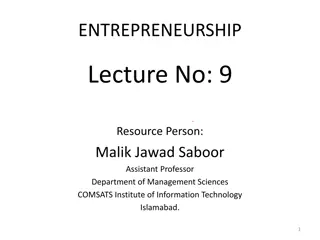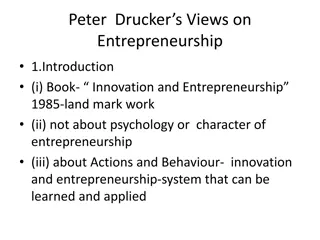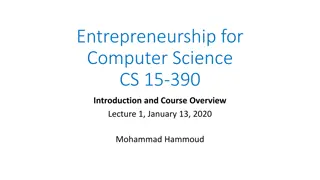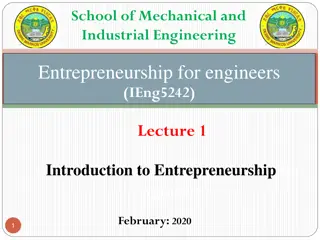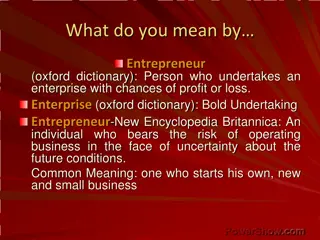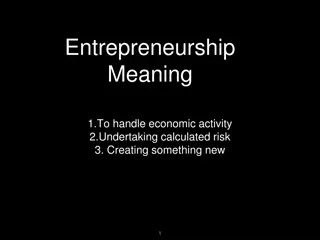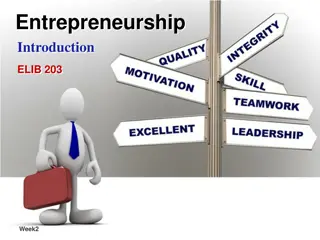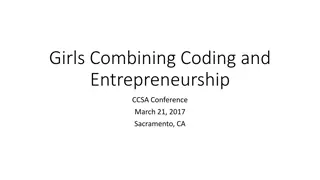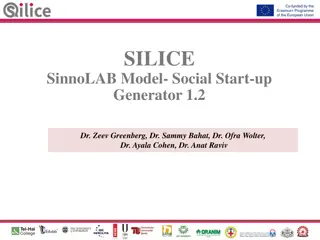Relationship Between Demographics and Entrepreneurship
The study explores how demographics influence entrepreneurship rates, showing that older countries tend to have lower rates compared to younger countries. It highlights the importance of creativity, energy, and experience in starting and running a business, with specific implications on age and workforce composition. The findings suggest a complex relationship between age, country aging, and entrepreneurship rates, with young countries offering more opportunities for skill acquisition.
Download Presentation

Please find below an Image/Link to download the presentation.
The content on the website is provided AS IS for your information and personal use only. It may not be sold, licensed, or shared on other websites without obtaining consent from the author. Download presentation by click this link. If you encounter any issues during the download, it is possible that the publisher has removed the file from their server.
E N D
Presentation Transcript
Demographics and Entrepreneurship James Liang, Hui Jackie Wang and Edward P. Lazear November, 2014
General Intuition Need creativity and energy to start a business Also need some skills, which requires experience High level experience more valuable for producing human capital needed for entrepreneurship Young countries provide more opportunities for young to acquire skills because they take on more responsibility in firms in which they work 2
Main Implications and Findings Older countries (measured by shrinkage parameter or median age) have lower average entrepreneurship rates Older countries (measured by shrinkage parameter or median age) have lower entrepreneurship rates for individuals of any given age The smaller the share of the workforce older than a cohort, the higher the rate of entrepreneurship for that cohort (rank effect) For any given share of the workforce above a cohort, the lower is age, the higher the rate of entrepreneurship (creativity effect) The relation of entrepreneurship to age is inverted u-shaped (combination of the two effects) Entrepreneurship rates decline with country aging most for middle- age individuals 3
Figure 1. Countries with young and old labor forces .14 .12 Entrepreneurship Rate .1 .08 .06 .04 .02 0 20 30 40 50 60 Age Young countries (Median age<=37) Middle countries (37<Median age<=41) Old countries (Median age>41) Note: 1. Younger countries have higher rates of entrepreneurship at every age 2. Relation of entrepreneurship to age is inverted u 3. Inverted u most pronounced among young countries 4
Two Parts to the Model Demographic structure Economics of becoming an entrepreneurship 5
Demographic Structure Cohort size (proportion) as function of age, a, and shrinkage parmeter, r r = ra ( , ) f a r e r 1 e Cumulative (proportion younger than age a) ra 1 e = ( , ) F a r r 1 e 6
Properties of Demographic Structure ra 1 e 2 d F = a Lemma 1. For ( , ) , There exists an such that for all F a r a , , ] 1 , 0 [ 0 a m m r 1 e drda 2 d F and for , . a 0 a m drda Lemma 1 says that the rank of the middle-aged workers shifts more with a reduction in the population growth rate than the rank of the very young and very old. ra dF 1 e Lemma 2.For and 0<a<1, = 0 F r dr 1 e This states that the proportion of people below age a decreases in r for all ages (0 and 1 excepted, of course). 7
The share below any age falls in r, the shrinkage parameter. It falls most for the middle aged. 2.5 2 1.5 1 0.5 r = -2.18(Uganda) r = 0 r = 0.22(Japan) 0 0 0.2 0.4 0.6 0.8 1 Normalized age (0=age 20, 1=age 65) 8
Economic Model of Entrepreneurship Value of entrepreneurship, v, depends on human capital, h, creativity, q, and luck, v =V(h, q) The risk-neutral worker will choose to start a business if v > 1 or if V(h,q) > 1/ P(x) is the probability that x>1/ so P(V(h,a)) is the proportion of workers who start a business Human capital: Let sa denote rank so sa=F(a,r). Then, h=H(s) withH >0. Creativity: q=Q(a). Creativity is assumed to decrease with age, Q'(a) < 0. Substituting, the proportion of workers of age a who start a business (denoted as E(a,r)) is given by = ( , ) ( ( ( ( , )), ( ))) E a r P V H F a r Q a or equivalently, G(a,sa) = P(V(H(sa),Q(a))) 9
Theoretical Results Proposition 1. Entrepreneurship at any given age a is decreasing in the population parameter, r. As r rises, reflecting both a declining and aging population, entrepreneurship falls. Specifically, ) , ( r E a r = 0 Corollary 1. For any given age group, a, the entrepreneurship rate rises in saor (This is the rank effect of human capital acquisition.) ( , ) G a s a 0 s a Corollary 2. For any given rank sa, the entrepreneurship rate falls in a or ( , ) G a s a 0 a (This is the creativity effect.) 10
. Theoretical Results, Continued Proposition 2. The number of entrepreneurs as a fraction of the workforce decreases as the population ages, i.e., / 0 d E dr Corollary 3. The number of entrepreneurs as a fraction of the workforce decreases with the population s median age. Proposition 3 There exists an age am with 0 < am < 1 such that E(am , r ) > E(a, r) a am . (The relation of entrepreneurship to age has an inverted-u shape.) Proposition 4. There exists some aM, 0<aM<1 such that ( , ) , 1 ( ) E a r E r ( , ) , 0 ( ) E a r E r M M and r r r r (Entrepreneurship rates shift the most with demographic structure for middle-aged workers.) 11
Summary of Empirical Implications 1. Within any country, the effect of age on entrepreneurship is negative, holding the share of those below that age group constant. 2. Holding age constant, the higher is s(a), the higher is the rate of entrepreneurship. 3. Countries that are aging more quickly, captured by higher levels of r, should have lower rates of entrepreneurship at any given age. 4. Categorizing countries by their r, those with higher values of r should have lower rates of entrepreneurship overall. 5. It also follows that countries with higher median ages should have lower entrepreneurship rates. 6. Within a country, entrepreneurship rates rise with age and then decline after some point. 7. The entrepreneurship rates of the middle-aged are most sensitive to cross-country changes in r. 12
Data Global Entrepreneurship Monitor Survey 2000-2010 (not all countries all years) 1.3 million individuals 15-60 years old 82 countries Entrepreneurship defined a number of ways. For most, used Manages and owns a business that is up to 42 months old and pays wages 13
Data US Census Bureau s International Data Base Population counts for 200 countries Ages 0 to 100 Used by GEM to calculate sampling weights 14
Data Country Characteristics GDP-per-capita: Penn World Table (PPP in 2005 dollars) Tertiary education completion rates: Barro and Lee (2010). Start-up costs: World Bank Database Property rights index: Property Rights Alliance 15
Table 1. Summary Statistics Overall (N=82) Mean OECD (N=31) Mean Non-OECD (N=51) Mean Std Std Std Entrepreneurship rate Alternative definitions 0.06 0.06 0.03 0.01 0.09 0.08 Early-stage, pay wage (esentr) 0.06 0.06 0.03 0.01 0.09 0.08 Early-stage + Shutdown (esentr_shd) 0.11 0.11 0.05 0.02 0.15 0.13 Nascent, not-pay wage (nascent) 0.07 0.06 0.04 0.02 0.09 0.08 Total Early Stage (tt_esentr) 0.12 0.11 0.06 0.03 0.17 0.13 With high aspiration Plan to hire 5 in 5 years (esentr_ha5) Plan to hire (esentr_ha10) New product/market (esentr_newps) 0.010 0.009 0.006 0.004 0.013 0.011 10 in 5 years 0.005 0.005 0.003 0.002 0.006 0.006 0.011 0.015 0.007 0.006 0.015 0.020 Demographic (among age 20-64) -0.63 0.64 -0.17 0.35 -1.01 0.58 Cohort shrink rate ( r) 39.55 2.52 41.34 1.40 38.04 2.25 Average age 38.74 3.50 41.19 1.96 36.68 3.18 Median age 0.52 0.09 0.46 0.05 0.57 0.08 Percentage of young (20-45) Other Characteristics 19032 13230 30036 9819 9802 7306 GDP per capita $ 11.23 6.73 15.59 6.28 7.58 4.64 College enrollment rate % 17.01 6.02 34.51 1.34 6.47 7.10 6.90 1.00 25.86 5.11 44.80 0.79 Start-up cost (% of GNP per capita) Property right index % 16
Results Demographic Model Fits well Estimate r non-linearly for each country (45 age group observations) from 1 e a r e = s a r 1 sa Then get correlation of sa with 2561 age-country cells in 2010 R-squared is .998 17
Aging Countries Have Less Entrepreneurship VUT VUT GHA GHA Entrepreneurship rate for entire country Entrepreneurship rate for entire country .25 .25 UGA UGA .2 .2 AGO AGO ZMB ZMB .15 .15 BOL BOL BRA BRA ECU COL ECU COL CHN CHN .1 .1 GTM GTM ARG ARG TTO PER PER CHL TTO IRN JAM IRN CHL JAM .05 .05 KOR LVA KOR LVA MKD MNE RUS TUN TUR TUN TUR EGY AUS BIH HUN ISL PRT RUS EGY AUS BIH ESP TWN TWN URY URY CRI MYS CRI MYS SAU SAU FIN FIN GBR GRC NOR SVN SWE GBR GRC HUN NOR PRT USA MKD CHE FRA HRV ITA ISL CHE FRA HRV SVN MNE DNK NLD DNK USA IRL IRL DEU NLD PAK PAK SWE DEU JPN MEX MEX ISR ISR JPN ESP ROU BEL BEL ITA ROU 0 0 30 35 40 45 -2 -1.5 -1 -.5 0 Median age (20-64) Parameter r 18
Results:Country Comparisons Table 2. Country-Year Level Entrepreneurship Rate Regression Dep. Var. Babybuso Sample specifics r All (1) -0.041 OECD (2) -0.023 All (3) OECD (4) All (5) -0.027 OECD (6) -0.031 All (7) -0.047 OECD (8) -0.05 All (9) [0.007]*** [0.007]*** [0.009]*** [0.007]*** [0.024]* [0.023]** Median age -0.007 -0.004 -0.002 (age 20-64) [0.001]*** [0.001]*** [0.002] GDPpc -0.000 [0.000]* 0.03 [0.044] -0.000 [0.000] 0.023 [0.032] Tertiary Start-up Cost 0.032 0.021 [0.017]* 0.002 [0.019] 0.007 IPRI [0.004] [0.003]*** GDP growth rate 0.001 [0.001] 0.006 0.001 [0.001]* -0.04 Constant 0.01 0.022 0.318 0.17 -0.024 0.027 0.128 [0.004]** [0.004]*** [0.051]*** [0.043]*** [0.023] [0.017]** [0.040] [0.010]** [0.071]* Year FE Country FE Obs R-square Y Y Y Y Y Y Y Y 393 0.91 Y Y 230 0.72 Y Y 393 0.9 393 0.4 230 0.24 393 0.37 230 0.19 388 0.45 230 0.35 Note: Observations are weighted by the number of individuals who make up each country-year cell. Standard errors clustered at the country level are in parentheses. * Significant at 10%; ** significant at 5%; *** significant at 1%. 19
Summarizing Table 2 Higher r (older, shrinking population), the lower the rate of entrepreneurship (columns 1 and 2 and Proposition 2) US with r=-.1 would have entrepreneurship rate 61% higher than Japan, with r=.22. Higher median age, the lower the rate of entrepreneurship (columns 3 and 4 and Corollary 3) One s.d. decline in median age results in 2.5 percentage point increase in entrepreneurship, which is over 40% of mean rate of .06 Including controls (GDP, education, cost of startup, property rights) does not change conclusion Conclusion holds, albeit weaker, even within country (country fixed effects included) 20
Results: Country Age Relationships Table 3 Entrepreneurship rate within country-age cell Dep. Var. Sample specifics All OECD All OECD All OECD All (1) -0.028 (2) -0.023 (3) -0.376 (4) -0.191 (5) -0.189 (6) -0.104 (7) 0.045 a [0.003]*** [0.003]*** [0.057]*** [0.049]*** [0.025]*** [0.036]*** [0.009]*** r -0.038 -0.021 [0.007]*** [0.007]*** 0.336 0.164 0.156 0.079 sa [0.054]*** [0.048]*** [0.024]*** [0.036]** -0.085 a2 [0.008]*** 0.025 0.033 0.038 0.04 0.046 0.04 0.035 Constant [0.004]*** [0.004]*** [0.003]*** [0.003]*** [0.003]*** [0.002]*** [0.004]*** Y Y Y Y Y Y Y Year dummies Y Y Country FE Obs R-square 17554 0.26 10309 0.12 17554 0.25 10309 0.12 17554 0.56 10309 0.24 17554 0.11 Note: Observations are weighted by the number of individuals who make up each country-age-year cell. Standard errors clustered at the country level are in parentheses. 21 * Significant at 10%; ** significant at 5%; *** significant at 1%.
Summarizing Table 3 Age, a, enters negatively (creativity effect), r, population shrinkage parameter, (human capital rank effect) enters negatively (columns 1 and 2, and Proposition 1) Also, a enters negatively, sa, share younger than age a (human capital rank effect), enters positively (columns 3 and 4 and Corollaries 1 and 2) True even with country fixed effects, reflecting importance of within-country age variation (columns 5 and 6) Relation of entrepreneurship to age is inverted u (column 7 and Proposition 3) 22
More Refined Tests Each age group provides a potentially independent test across countries so 45 tests Table 4 allows every age group to have its own effect of r and a different constant term The effect of r is negative and significant in almost all cases (Proposition 1) which is strong support of the human capital rank effect Three versions: just r (one intercept) varies by age group R2 = .23 just a (45 intercepts) varies by age group R2 = .09 both r and intercepts vary by age group R2 = .25 Most of the action is in r Table 5 repeats the analysis but uses sa instead of r. Results are parallel (Corollaries 1 and 2) Age dummies become more negative with age, reflecting the creativity effect 23
Population Aging Affects Middle Age Workers Most (Proposition 4) Figure 4. Absolute value of the coefficients on r by Age in the Age-specific Entrepreneurship Rate Regression 0.06 Absolute value of coefficient on r 0.04 0.02 0.00 20 30 40 50 60 Age Note: This figure plots the magnitude of the age-specific coefficient on r reported in column 1 of Table 4. 24
Entrepreneurship Peaks in Middle Age (Proposition 3) r = -2.18 (Uganda) r = -1 r = -0.5 r = 0.22 (Japan) 0.12 0.1 Predicted Entrepreneurship Rate 0.08 0.06 0.04 0.02 0 20 25 30 35 40 45 50 55 60 65 Age 25
Using Different Definitions of Entrepreneurship Does not Affect Conclusions Early-stage entrepreneur plus those that have died in last twelve months Nascent business are less than 42 months old, but do not pay wages Nascent plus early stage High aspiration entrepreneurship expect to hire more than five employees in next ten years expect to hire more than ten employees in next ten years 26
Causation and Alternatives Reverse causation: Entrepreneurship causes age structure Only possible for immigration Implausible: Too small an effect on median age Theory is specific with respect to details. All supported. Alternatives Older countries are more developed GDP-per-capita and education do not affect results Older countries are poorer prospects for investment GDP growth rates do not affect results These alternatives do not predict the inverted u nor the change in entrepreneurship among middle aged being the most pronounced 27
Summary Human capital framework coupled with demography provides strong theoretical predictions for entrepreneurship and aging Seven specific predictions the most important being aging societies have less entrepreneurship entrepreneurship rate is lower in aging societies at every age because the creativity and human capital rank effect work in opposite directions, entrepreneurship rates peak in middle age All theoretical predictions are borne out 28





